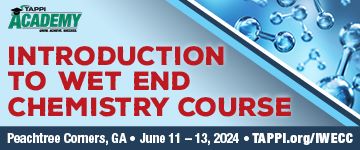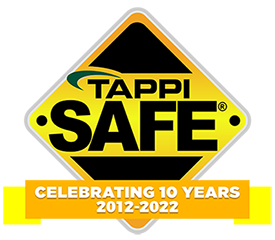 Search
Search
Use the search bar or filters below to find any TAPPI product or publication.
Filters
Content Type
Publications
Level of Knowledge
Collections
Journal articles

Magazine articles

Effects of tissue additives on copy paper forming and properties, TAPPI Journal February 2024
ABSTRACT: Laboratory tests were conducted in an effort to determine the effects on paper machine process attributes and the properties of paper made from recycled copy paper furnish upon the addition of chemical agents that are commonly used in the production of hygiene tissue products. Due to continuing growth in tissue and towel grades of paper, such agents are experiencing greater usage. Charge titration test results revealed that certain dry strength agents associated with tissue manufacturing have the potential to shift the balance of charge in papermaking furnish to less negative or even positive values. Creping adhesive was found to contribute to fine particle retention, especially when present at relatively high levels. Release aid and a polyacrylate dispersant had the opposite effect. Low addition levels of both a creping adhesive and a debonding agent surprisingly increased a wide range of strength attributes of paper handsheets in comparison to sheets prepared from unaltered recycled copy paper furnish. The debonding agent decreased paper strength at higher levels of addition. Such effects appear to depend not only on the expected effects of agents themselves, but also on how they affect the charge balance of the wet-end system.
Journal articles

Magazine articles

Effects of carboxymethyl starch as a papermaking additive, TAPPI Journal February 2024
ABSTRACT: Carboxymethyl starch (CMS) is a bio-based, anionic polymer that has potential as part of a dry-strength additive program for papermaking. Due to its negative charge, its effects can be expected to depend on its interactions with various cationic agents. In this work, the effects of CMS were observed following its sequential addition after one of three selected cationic strength agents at different dosage levels. In selected tests, the furnish was pretreated at the 1% level by a dispersant, sodium polyacrylate, which might represent a high level of anionic contaminants in a paper mill system. Laboratory tests were conducted to show the effects on dewatering, fine-particle retention, and flocculation. These tests were supplemented with measurements of charge demand, zeta potential, and handsheet properties. Sequential addition of cationic glyoxylated acrylamide copolymers (gPAM) and CMS were found to strongly promote dewatering. Two gPAM products and a poly(vinylamine) product in sequential addition with CMS were very effective for promoting fine-particle retention. These same sequential treatments of the stock contributed to moderate fiber flocculation, though severe flocculation was caused by further treatment of the furnish with colloidal silica. Handsheet strength results were mixed. In the default recycled copy paper furnish, the average breaking length for the sheets made with cationic additives followed by CMS was not greatly different from the blank condition. Superior strength resulted when the default furnish was treated with a dispersant alone. When the dispersant-contaminated furnish was treated with the same combinations of cationic additives and CMS, the strength returned to the baseline achieved in the absence of the dispersant. The results were discussed in terms of the charged character of the different additives and their interactions not only with the fiber surfaces but also with each other.
Journal articles

Magazine articles

Control of malodorous gases emission from wet-end white water with hydrogen peroxide, TAPPI Journal October 2021
ABSTRACT: White water is highly recycled in the papermaking process so that its quality is easily deteriorated, thus producing lots of malodorous gases that are extremely harmful to human health and the environment. In this paper, the effect of hydrogen peroxide (H2O2) on the control of malodorous gases released from white water was investigated. The results showed that the released amount of total volatile organic compounds (TVOC) decreased gradually with the increase of H2O2 dosage. Specifically, the TVOC emission reached the minimum as the H2O2 dosage was 1.5 mmol/L, and meanwhile, the hydrogen sulfide (H2S) and ammonia (NH3) were almost completely removed. It was also found that pH had little effect on the release of TVOC as H2O2 was added, but it evidently affect-ed the release of H2S and NH3. When the pH value of the white water was changed to 4.0 or 9.0, the emission of TVOC decreased slightly, while both H2S and NH3 were completely removed in both cases. The ferrous ions (Fe2+) and the copper ions (Cu2+) were found to promote the generation of hydroxyl radicals (HO•) out of H2O2, enhancing its inhibition on the release of malodorous gases from white water. The Fe2+/H2O2 system and Cu2+/H2O2 system exhibited similar efficiency in inhibiting the TVOC releasing, whereas the Cu2+/H2O2 system showed better perfor-mance in removing H2S and NH3.
Magazine articles

Using climate change policies for u.s. pulp and paper industry efficiency, TAPPI JOURNAL, July 2000, Vol. 83(7)
Using climate change policies for u.s. pulp and paper industry efficiency, TAPPI JOURNAL, July 2000, Vol. 83(7)
Magazine articles

Industry leaders: jukka harmala leads stora enso into new global age, TAPPI JOURNAL, May 2000, Vol. 83(5)
Industry leaders: jukka harmala leads stora enso into new global age, TAPPI JOURNAL, May 2000, Vol. 83(5)
Magazine articles

What's new with tappi test methods?, TAPPI JOURNAL, September 2000, Vol. 83(9)
What's new with tappi test methods?, TAPPI JOURNAL, September 2000, Vol. 83(9)
Journal articles

Magazine articles

Development of converging-diverging multi-jet nozzles for molten smelt shattering in kraft recovery boilers, TAPPI Journal March 2021
ABSTRACT: The effective shattering of molten smelt is highly desired in recovery boiler systems. Ideally, shatter jet nozzle designs should: i) generate high shattering energy; ii) create a wide coverage; and iii) minimize steam consumption. This study proposes a novel converging-diverging multi-jet nozzle design to achieve these goals. A laboratory setup was established, and the nozzle performance was evaluated by generating jet pressure profiles from the measurement of a pitot tube array. The results show that the shatter jet strength is greater with a large throat diameter, high inlet pressure, and a short distance between the nozzle exit and impingement position. Increasing the number of orifices generates a wider jet coverage, and the distance between the orifices should be limited to avoid the formation of a low-pressure region between the orifices. The study also demonstrates that an optimized converging-diverging multi-jet nozzle significantly outperformed a conventional shatter jet nozzle by achieving higher energy and wider coverage while consuming less steam.
Journal articles

Magazine articles

Quantification of vegetable oil in recycled paper, TAPPI JOURNAL September 2020
ABSTRACT: Vegetable soybean oil is commonly used in cooking foods that are packaged in takeaway paper-board containers. Vegetable oil is hydrophobic, and in sufficiently high concentration, could interfere with interfiber bonding and result in paper strength loss. In order to quantify the effect of oil on the resulting paperboard strength, it is necessary to quantify the oil content in paper. A lab method was evaluated to determine the soybean oil content in paper. Handsheets were made with pulps previously treated with different proportions of vegetable oil. Pyrolysis gas chromatography-mass spectrometry (pyGCMS) was used to quantify the amount of oil left in the handsheets. The results revealed a strong correlation between the amount of oil applied to the initial pulp and the amount of oil left in the handsheets.In addition, the effect of vegetable oils on paper strength may be affected by the cooking process. Vegetable oil is known to degrade over time in the presence of oxygen, light, and temperature. The vegetable oil was put in an oven to imitate the oil lifecycle during a typical pizza cooking process. The cooked oil was then left at room temperature and not protected from air (oxygen) or from normal daylight. The heated, then cooled, oil was stored over a period of 13 weeks. During this time, samples of the aged oil were tested as part of a time-based degradation study of the cooked and cooled oil.
Magazine articles

Energy: recovering capital and cutting costs, TAPPI JOURNAL, November 2000, Vol. 83(11)
Energy: recovering capital and cutting costs, TAPPI JOURNAL, November 2000, Vol. 83(11)
Magazine articles

Mönsterås going 100% TCF as it increases production and minimizes emissions, December 1995 Tappi Journal [95Dec49.pdf]
Monsteras going 100% tcf as it increases production and minimizes emissions, TAPPI JOURNAL, December 1995, Vol. 78(12)






